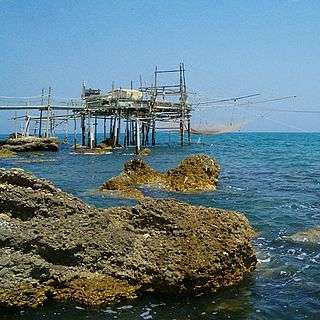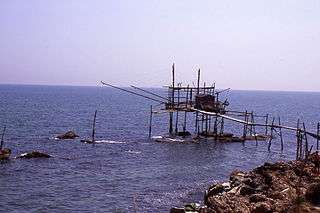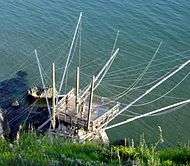Trabucco
| Look up trabucco in Wiktionary, the free dictionary. |


The trabucco (Italian pronunciation: [traˈbukko] or trabocco; in some southern dialects called travocc) [1] is an old fishing machine typical of the coast of Abruzzi region (specially in the Trabocchi Coast or Costa dei Trabocchi) and also in the coast of Gargano, where it is protected as historical monuments by the homonym National Park. Spread along the coast of southern Adriatic especially in the Italian provinces of Chieti, Campobasso, and Foggia and also in some parts of the coast of southern Tyrrhenian Sea.
Construction features
A trabucco is a massive construction built from wood, which consists of a platform anchored to the rock by large logs of pine of Aleppo, jutting out into the sea, from where two (or more) long arms called antennae stretch out suspended some feet above the water and supporting a huge, narrow-meshed, net (called trabocchetto).
The morphology of the Gargano coast and of Abruzzo determined the presence of two different types of trabucco: the Garganic trabucco is usually anchored to a rocky platform, longitudinally extended to the coastline, from which the antennae depart.
The variant of Abruzzo and Molise, also called bilancia, often insists on shallower coasts and therefore is characterized by the presence of a platform, transversal to the coast, which is connected by a tight bridge made of wooden boards. A bilancia has just one winch, often electrically operating, even when the sea is perfectly calm. Abruzzo bilancia has also a net much smaller than that of Gargano trabucco, another feature that differentiates the two types is the length and number of antennae, more extensive Gargano (also double that of Abruzzo and Molise) in Termoli balances were more than two antennae, Gargano always two or more.[2]
History
According with some historians of Apulia, the trabuccco was invented in the region imported from Phoenicians. The earliest documented existence dates back to 18th century, during which Gargano fishermen, during that period sparsely populated, devised an ingenious technique of fishing which wasn't subject to weather conditions in the area. Trabucchi were built in the most prominent promontories jutting nets out to sea through a system of monumental wooden arms: a trabucco allows to fish without having to be submitted to sea conditions using the morphology of Gargano rocky coast.
The trabucco is built with traditional wood Aleppo pine -the typical pine of Gargano and common throughout the South-Western Adriatic- because this material is virtually limitless (for his dissemination in the area) modeled, elastic, weatherproof and resistant to salt (trabucco must resist to strong Mistral usually blowing in these areas). Some trabucchi have been rebuilt in recent years, thanks to public funds.[3] However, since they lost their economic function in the past centuries when they were the main economical source of entire families of fishermen, trabucchi rose into the role of cultural and architectural symbols and tourist attraction.
Fishing system


The fishing technique, quite efficacious, is "on sight". It consists of intercepting, with wide nets, the flows of fish moving along the ravines of the coast. Trabucchi are located where the sea is deep enough (at least 6 meters), and are built on rocky peaks generally oriented southeast or north in order to exploit the favorable marine current.
The net is lowered into the water through a complex system of winches and, likewise, promptly pulled up to retrieve its catch. At least two men are entrusted with the tough task of operating the winches that maneuver the giant net. Small trabucchi of Abruzzo and Molise Coast are often electrically powered.
The trabucco is managed at least by four fishermen called ""trabuccolanti"" who share the duties of watching the fish and maneuvering.
Distribution
The trebuchets are a distinguishing feature of the coastal landscape of the lower Adriatic. Their presence is also attested on the lower Tyrrhenian Sea.
Disseminated throughout the Trabocchi Coast in the Abruzzi region where are those called travocchi (in dialect of Molise and Abruzzo) in the province of Campobasso, Termoli, Chieti and south of Ortona and in the Gargano coast, more widely present in the area between Peschici and Vieste (where there isn't any promontory without one of these giant structures), the ancient trabucchi are protected by the National Park of Gargano, which adopted them as a sign of respect for tradition and environment of the Gargano, as a symbol of civilization, are now following the favorite subject of artists and craftsmen.
Costa dei Trabocchi
The Trabocchi Coast (Costa dei Trabocchi) is a stretch of coast province of Chieti, which includes the countries situated between Francavilla al Mare and Vasto. The coast is full of quaint fishing overflow, some of which have been converted into restaurants. The coast is also known for the presence of the so-called " Dannunzio's hermitage" (promontorio dannunziano), where stands the villa that the poet Gabriele d'Annunzio used with his mistress for the writing of his novel Trionfo della morte.
The cities of the coast are:

- Francavilla al Mare
- Ortona
- San Vito Chietino
- Rocca San Giovanni
- Fossacesia
- Torino di Sangro
- Casalbordino
- Vasto
- San Salvo
Notes
- ↑ original meaning is trap or deep trap, then the term was applied to high military wooden construction (trebuchet) and over several centuries, was used in the Middle Ages to besiege rivals fortresses. See: Ottavio Lurati,Toponimi e Géologia, in Semantic, XXIX, Number 2, December 2008, 446.
- ↑ I trabucchi del Gargano, by Maria Teresa Rauzino, Rita Lombardi, Raffaella Specchiulla, Ignazio Polignone, 2007
- ↑ such as the Abruzzo regional law n. 99 of 16/9/1997
References
- Paula Hardy, Abigail Hole, Olivia Pozzan, Puglia & Basilicata, 2008, ISBN 1-74179-089-1, page 93
- P. Barone, L. Marino, O. Pignatelli, I Trabocchi, Macchine da pesca della costa adriatica, CIERRE edizioni, 1999 (Italian)
- M. Fasanella, G. De Nittis, Il Trabucco, Vieste FG, Grafiche Laconeta, 1992 (Italian)
- Pietro Cupido, Trabocchi, Traboccanti e Briganti, Ortona CH, Edizioni Menabò, Libreria D'Abruzzo
- Teresa Maria Rauzino, Rita Lombardi, Raffaella Specchiulli, Ignazio Polignone, I trabucchi della costa garganica (Italian)
See also
| Wikimedia Commons has media related to Trabucchi. |
Trabucco's area of diffusion
Area of diffusion of Trabocco or Bilancia variants
